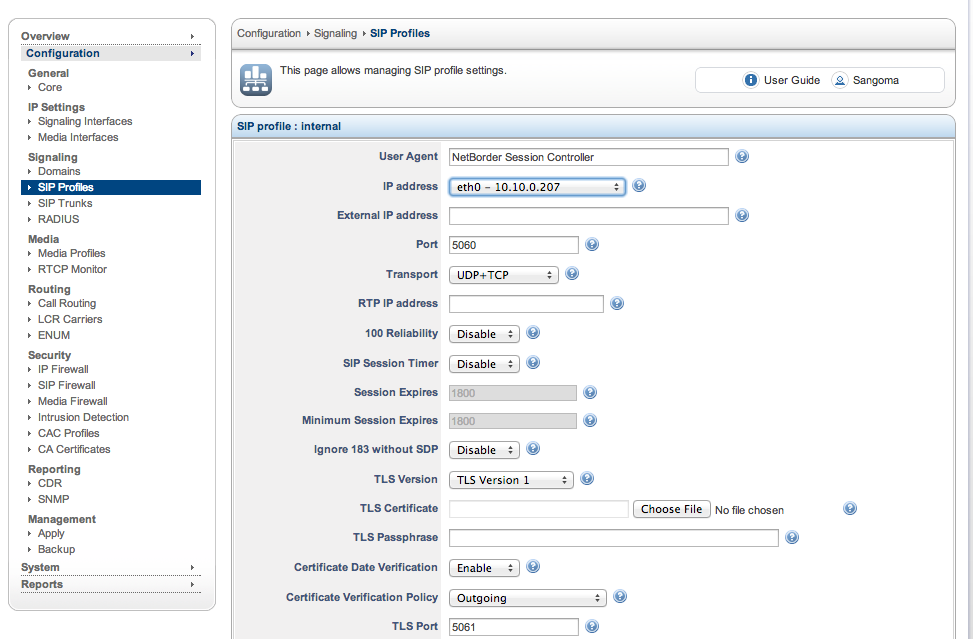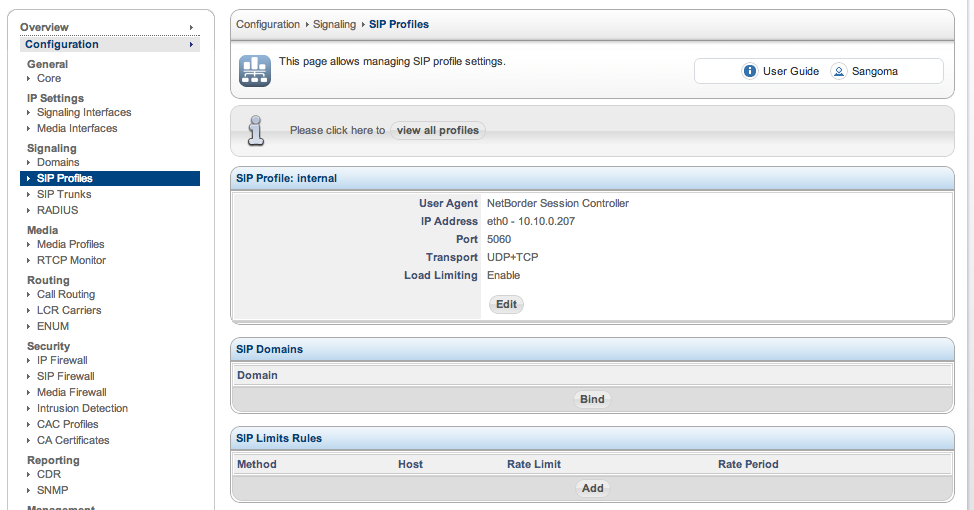SIP Profile Configuration
- SIP Profile Overview
SIP Profile 是一个SBC的帐号,包含了一系列的SIP配置属性和SBC本身关联。 SIP profile 用来配置如何支持外部的终端连接到SBC设备。 用户绑定一个IP地址,端口和其他相关的功能设置。 用户也同样绑定了call routes, domain profiles, media profiles, 和 SIP trunks,并且关联到SIP profiles。
SIP profile 包含了SIP UA 配置。 Sangoma SBC can be configured to behave as multiple UA each with a different configuration (and therefore a different set of IP:port pair each).
SIP Profile describes information that is local to the SBC Information needed for remote user agents to connect to Sangoma SBC.
Local listening port Local authentication user information Local transport info: TCP,UDP etc..
- SIP Profile Configuration
You can create SIP profiles by going to “Configuration -> Signaling -> SIP Profiles”.
 Sangoma SBC SIP Profile Add
Sangoma SBC SIP Profile Add
For the SIP profile name, use a descriptive name (no spaces) such as “internal”, “internal-network”, “external-users” etc.
- Remember a SIP profile is a SIP UA that will be used to communicate with other SIP UA (ie SIP phones) or Servers (ITSP, SIP Proxies etc)
Once you click “Create”, you will get a configuration page for the new SIP profile that allows you to specify: all the details about your new SIP profile including the IP information to be used, TLS/SRTP settings, etc.
Pay special attention to the following fields:
SIP Profile Field Description IP Address This is the IP address where NSC will listen for calls Transport Most implementations will want to leave the default “UDP+TCP”, this means SIP packets will be accepted in both UDP and TCP protocols. Port Most of the time you will want to leave the default 5060 port. Authenticate Calls This means any SIP calls (INVITE requests) will be accepted and not challenged. Routing Plan: You have to choose the routing plan you created before () ! Security Note: If you Disable Authenticate Calls in the SBC, take care that the remote SIP UA, eg: IP IPBX has authetication enabled.
! Security Note: if you are exposing a SIP Profile to the public internet, you may want to change its Port to something different than default 5060, in order to reduce attach exposure.
Many malicious tools scan for for 5060 to find SIP systems connected to the internet. Even though Sangoma SBC comes with several protection mechanisms to detect scans, you will be better off on the internet by using a different port.

- The contextual help on each field will give you information about what each field in the SIP profile does.
When done configuring the SIP profile click “Save”.
You can now proceed to optionally bind one or more domains to this SIP profile. When you bind a domain to a SIP profile you are attaching all the user directory of each domain bound for this SIP profile to be able to accept registrations and/or perform authentication of SIP INVITE messages based on the user/password information stored in the domain user directory (or performed via authentication forwarded according to the domain configuration).
- Note that in order to perform SIP authentication you have to set the “Authenticate Calls” parameter to “Enable”.
To bind a domain to a SIP profile simply click “Bind” in the SIP profile modification page:
 Sangoma SBC SIP Profile Mobile
Sangoma SBC SIP Profile Mobile
Then choose the domains you which to bind.
 Sangoma SBC SIP Profile bind domain
Sangoma SBC SIP Profile bind domain
Finally click “Bind”. You will see now the domain listed in the SIP profile page.